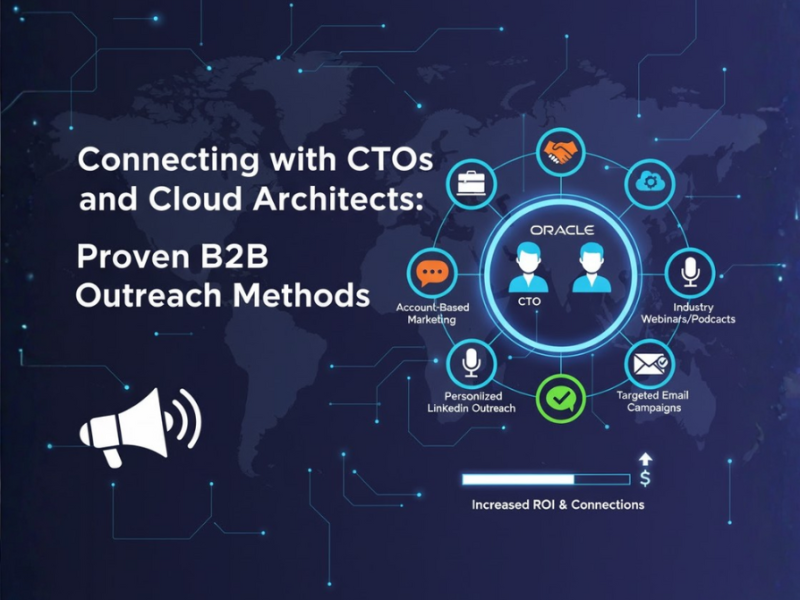You’re sitting on a valuable asset: a list of companies and contacts you know use SAP. But are you treating it like a high-potential pipeline or just another contact list? For most businesses, it’s the latter. This is a massive missed opportunity.
It’s a common mistake to either let this list gather digital dust or, worse, hit it with generic sales pitches that fall completely flat. This happens because the SAP ecosystem is unique – it’s a world of sophisticated users who value deep expertise and are immune to flavor-of-the-month marketing. They don’t want a sales pitch; they want a strategic partner.
This article provides a clear, 7-step framework to transform your raw SAP users list into a predictable pipeline of qualified leads. By implementing a strategic lead nurturing campaign, you can build trust, demonstrate value, and drive significant revenue from an audience that is already within your reach.
Segment Your SAP Users List for Precision Targeting
Before you send a single email, you must segment your list. A one-size-fits-all approach is the fastest way to be ignored. True personalization, the kind that gets results in B2B lead nurturing, begins with intelligent segmentation. Sending the right message to the right person is non-negotiable.
Start by grouping your contacts based on meaningful criteria:
- By SAP Product/Module: Are they using S/4HANA, SuccessFactors, Ariba, or Concur? Their challenges and needs will vary dramatically.
- By Industry: A user in manufacturing has different priorities than one in finance or retail.
- By Company Size: The needs of a mid-market company are vastly different from those of a global enterprise.
- By Job Role: An IT Director cares about integration and security, while a Finance Manager is focused on ROI and compliance.
For instance, a message for a Finance Manager using SAP S/4HANA in the manufacturing sector should be fundamentally different from a message to an HR specialist using SuccessFactors in retail. Segmentation makes this level of relevance possible.
Define the Customer Journey and Your Goals
With your segments defined, you need to map the path you want your contacts to take. The goal is to guide them from simply being a user to becoming a qualified lead. This customer lifecycle marketing approach typically follows a simple journey:
- Awareness: The user becomes aware they have a problem or an opportunity for improvement.
- Consideration: The user begins to research and evaluate potential solutions to that problem.
- Decision: The user is ready to speak with a vendor and make a purchase decision.
Your nurturing goals should align with this journey. It’s not always about an immediate sale. Your goals could be to educate users about a new integration you offer, drive sign-ups for a targeted webinar, or encourage downloads of an in-depth white paper. The objective is always to offer value first.
Develop Value-Driven Content for Each Stage
Content is the fuel for your lead nurturing engine. To effectively nurture leads, you need to create assets that align with the customer journey you just defined.
- Top-of-Funnel (Awareness): At this stage, focus entirely on education, not your product. Help your audience do their job better or understand an industry trend.
- Content Ideas: Blog posts (“5 Ways to Optimize Your Supply Chain with S/4HANA”), industry reports, short video explainers.
- Middle-of-Funnel (Consideration): Now you can begin to introduce your company as a viable solution to the problems you’ve been discussing.
- Content Ideas: Detailed case studies, expert webinars, and white papers that compare different approaches.
- Example in action: A compelling case study can be your most powerful asset here. For instance, show how a manufacturing client reduced operational costs by 15% using your specific add-on for SAP.
- Bottom-of-Funnel (Decision): For contacts who have engaged with your mid-funnel content, it’s time to make a clear case for your solution.
- Content Ideas: Free trial offers, personalized demo invitations, and detailed pricing information.
Build the Automated Nurture Campaign
Manually sending this content would be impossible at scale. This is where marketing automation platforms (like HubSpot, Marketo, or Pardot) are essential. You can design a workflow that delivers the right content to the right person at the right time.
A simple yet effective email drip campaign could look like this:
- Email 1 (Value): Share a top-of-funnel blog post that speaks directly to the contact’s segment.
- Email 2 (Value + Soft Offer): A week later, share a relevant case study and invite them to an upcoming webinar.
- Email 3 (Hard Offer): For those who attended the webinar or downloaded the case study, send a personalized invitation for a one-on-one demo.
Remember to keep the cadence respectful. An email every one to two weeks is often enough to stay top-of-mind without becoming a nuisance.
Read More: How to boost ROI with technology data intelligence
Implement a Lead Scoring System
How do you know when a contact is ready to talk to sales? Lead scoring is the answer. This process involves automatically assigning points to leads based on who they are (demographics) and what they do (engagement). This is how you generate truly qualified SAP leads.
Here is a simple scoring example:
- +5 points for opening an email
- +15 points for downloading a white paper
- +25 points for visiting your pricing page
- +50 points for attending a webinar
You then establish a handoff threshold—a score (e.g., 100 points) at which a contact is considered a Marketing Qualified Lead (MQL) and is automatically routed to the sales team for follow-up.
Align Marketing and Sales for a Seamless Handoff
This step is critical for success and is where many SAP lead generation efforts fail. Marketing and sales must be perfectly aligned. This starts with a formal Service Level Agreement (SLA) that defines what an MQL is and specifies how quickly the sales team must follow up.
Most importantly, you must arm the sales team with context. When a lead is handed off, the salesperson must have full visibility into the lead’s activity.
Imagine the power of this: The salesperson knows the lead works in manufacturing, downloaded the supply chain white paper, and attended the webinar on cost optimization. They can open the conversation with, “I saw you were interested in our material on supply chain efficiency…” This is a highly relevant, warm conversation, not a cold call.
Measure, Analyze, and Optimize
A lead nurturing program is a living process, not a “set it and forget it” campaign. You must constantly measure performance to understand what’s working and what isn’t.
Key metrics to track include:
- Email open and click-through rates
- Content download and conversion rates
- MQL generation rate
- MQL-to-Sales-Qualified-Lead (SQL) conversion rate
- Overall campaign ROI
The data you gather proves the value of your efforts. Leading research shows that nurtured leads produce, on average, a 20% increase in sales opportunities versus non-nurtured leads.
Furthermore, with acquisition costs being up to five times higher than retention, focusing on upselling SAP customers through nurturing is a highly efficient growth strategy. Use this data to A/B test email subject lines, try different content offers, and fine-tune your lead scoring to continually improve your results.
Read More: Data Cleaning Is No Rocket Science
Your Strongest Pipeline is the One You Already Have
Your SAP hana users list is more than just data; it’s a community of professionals looking for expertise to solve their complex challenges. By shifting from selling to nurturing, you build the trust required to become their go-to partner.
The path to success is clear: Segment your list, define the customer journey, create valuable content, automate the campaign, score your leads, align with sales, and measure everything. This structured approach will turn a static list into a dynamic and predictable source of revenue.


